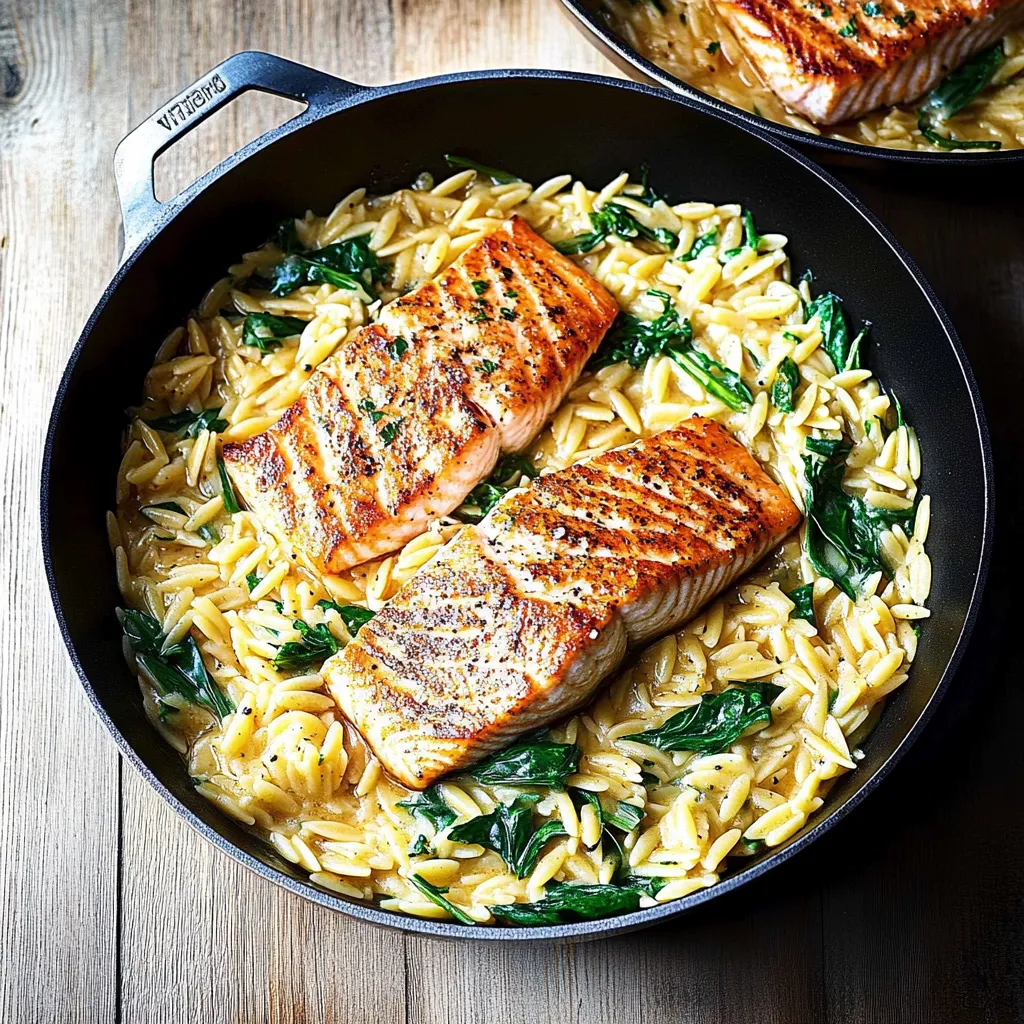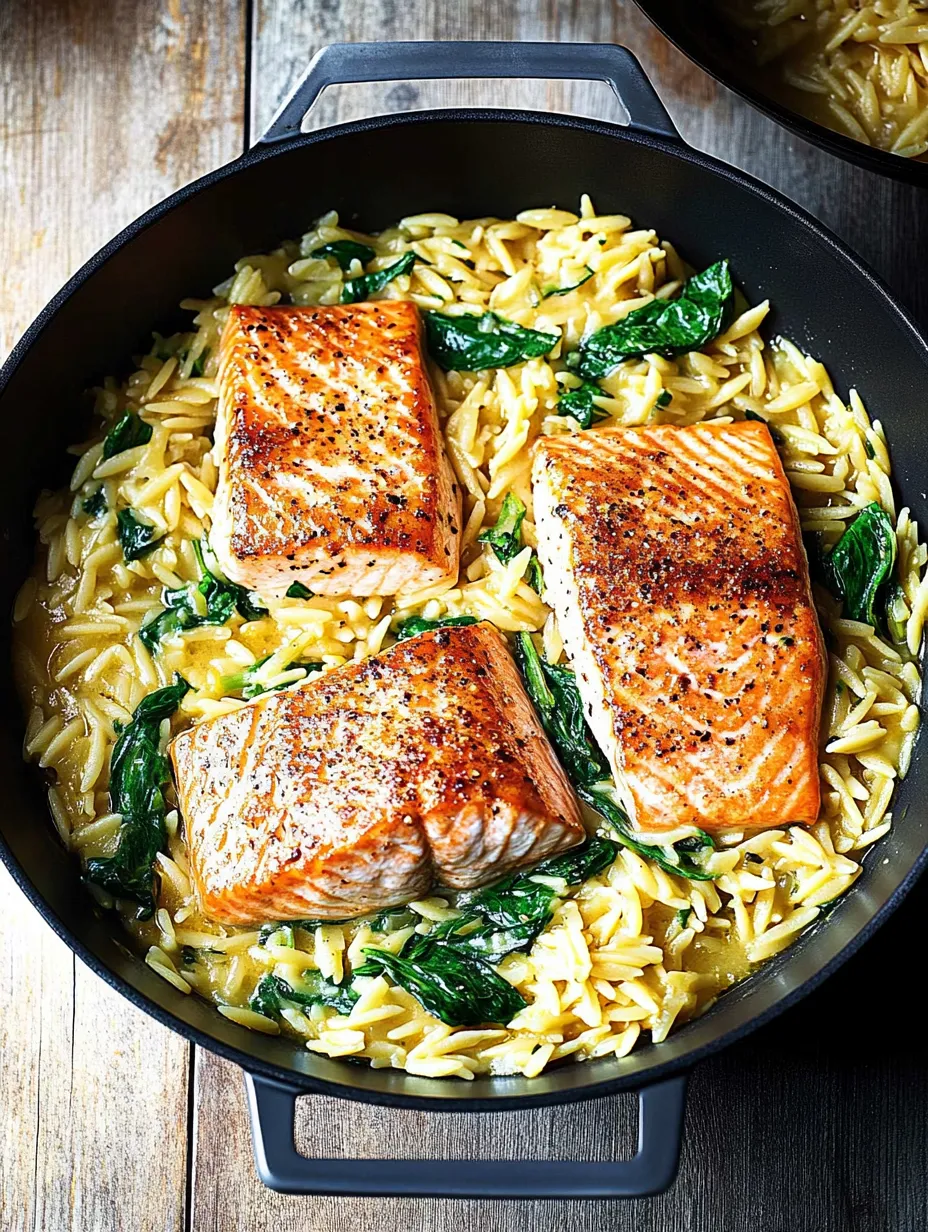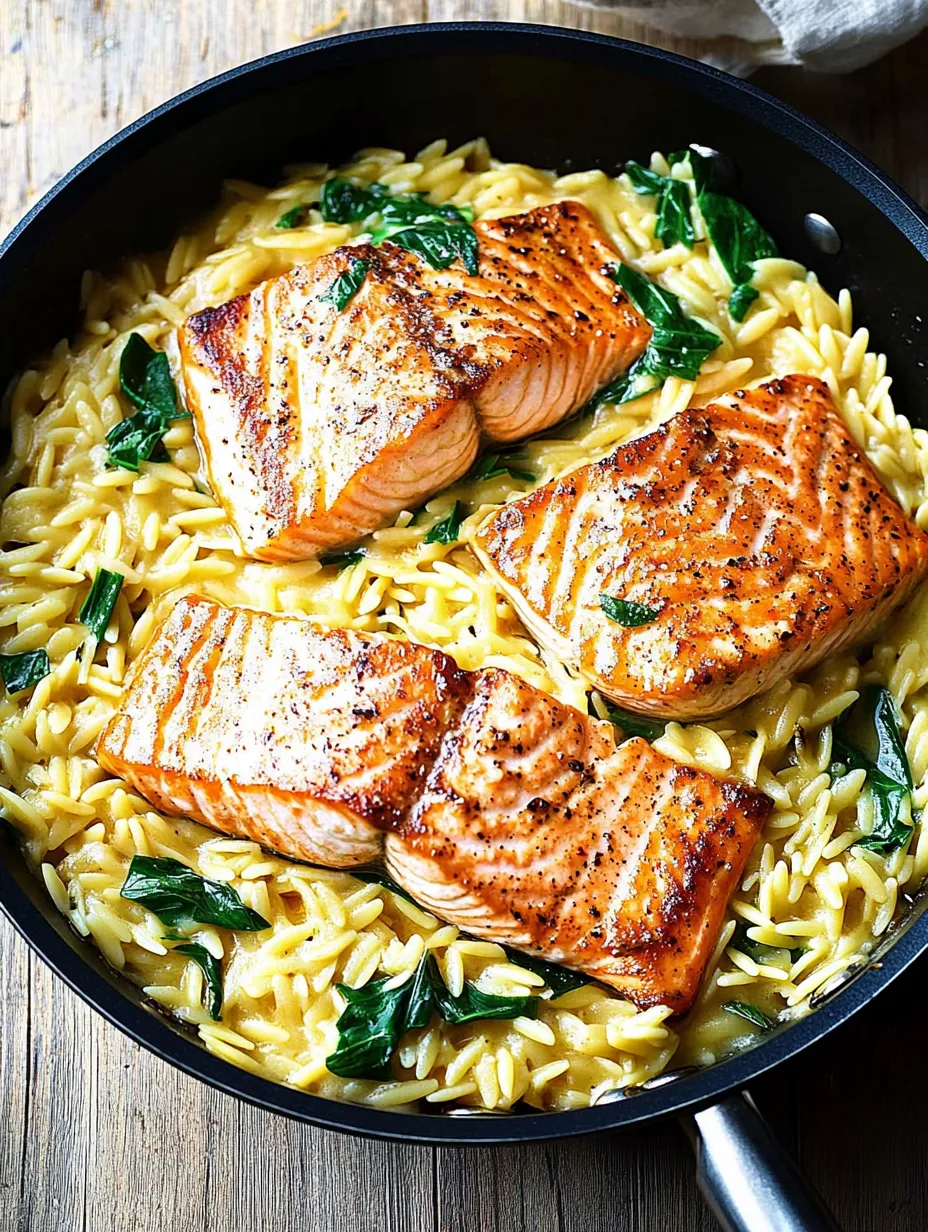 Save
Save
I discovered this recipe during a particularly busy week when I needed something impressive yet simple enough to make after a long workday. What began as an experiment with ingredients already in my pantry has become a regular favorite that my family requests regularly. The magic of cooking salmon and orzo together in a single skillet creates a meal that feels special without requiring hours in the kitchen or a sink full of dishes.
Last month when my sister visited, I made this for dinner after a full day of sightseeing. She watched me throw it together so quickly that she didn't believe it would taste like much. Two bites in, she was already taking photos of the recipe on her phone to make when she got home. That's how I know a recipe is truly a keeper.
Perfect Ingredients
- Salmon fillets - Look for pieces with equal thickness for even cooking; wild-caught offers the best flavor
- Orzo pasta - Creates a creamy, risotto-like base without the constant stirring
- Fresh spinach - Wilts perfectly into the orzo, adding color and nutrition
- Parmesan cheese - Freshly grated melts seamlessly into the orzo for richness
- Lemon juice - Brightens everything with acidity that balances the richness
- Chicken broth - Infuses the orzo with flavor as it absorbs the liquid

I once tried making this with pre-grated Parmesan when that's all I had on hand. While still good, the fresh stuff makes a noticeable difference in how smoothly it incorporates into the creamy orzo. Some shortcuts just aren't worth taking!
Dinner Magic
- Perfect Salmon
- Start by patting the salmon fillets completely dry with paper towels - this ensures a beautiful golden sear. Season generously with salt, pepper, paprika and garlic powder on both sides. Heat a combination of butter and olive oil in a large skillet until just starting to shimmer, then place the salmon presentation-side down and don't touch it for 3-4 minutes. This patience creates that restaurant-quality crust.
- Flavor Foundation
- After removing the salmon (it will finish cooking later), add finely diced onion to the same skillet, scraping up all those flavorful bits left behind. Once translucent, add minced garlic just until fragrant - about 30 seconds. This aromatic base infuses the entire dish with depth.
- Orzo Technique
- Add the uncooked orzo directly to the skillet and toast it briefly, stirring constantly for about a minute. This step adds a subtle nuttiness that elevates the final dish. Then add warm chicken broth and a sprinkle of dried thyme, stirring occasionally as the orzo absorbs the liquid - much like a no-fuss risotto.
- Green Addition
- When the orzo is nearly tender but still has some bite, stir in fresh spinach by the handful, letting each portion wilt before adding more. It will seem like too much at first, but quickly cooks down to the perfect amount. The residual heat does all the work.
- Finishing Touches
- Remove the skillet from heat before stirring in freshly grated Parmesan and a generous squeeze of lemon juice. This prevents the cheese from becoming stringy and allows the lemon to brighten without becoming bitter. Return the salmon to the skillet, nestling it into the orzo to warm through before serving.
My first attempt at this recipe taught me about timing - I overcooked the salmon during the initial sear, resulting in dry fillets by the time everything was ready. Now I make sure to undercook it slightly the first time, knowing it will finish perfectly when returned to the warm orzo.
Serving Style
This one-skillet wonder looks beautiful served family-style, straight from the pan at the center of the table. The vibrant green spinach and pink salmon create a naturally appetizing color palette. For more formal occasions, portion the creamy orzo onto warmed plates with a salmon fillet placed artfully on top. A small wedge of lemon and a sprinkle of fresh herbs make a simple but elegant garnish.
I often serve this with nothing more than a simple green salad dressed with olive oil and lemon juice. The dish is truly complete on its own, but crusty bread for soaking up any remaining sauce never goes unappreciated.
Creative Variations
While the classic version is perfect as is, small tweaks can create entirely new experiences. Try adding halved cherry tomatoes along with the spinach for bursts of sweetness. For a Mediterranean twist, include some kalamata olives and crumbled feta instead of Parmesan.
My favorite variation involves adding a splash of white wine to deglaze the pan after cooking the onions, allowing it to reduce before adding the broth. This adds wonderful depth and complexity to the orzo that complements the salmon beautifully.
Leftovers Strategy
This dish is best enjoyed fresh, but leftovers can be stored in an airtight container in the refrigerator for up to one day. When reheating, add a splash of water or broth to revive the orzo, and warm gently over medium-low heat. I sometimes deliberately make extra orzo (without salmon) to repurpose as a side dish the next day.
For longer storage, the orzo component freezes surprisingly well for up to three months. Thaw overnight in the refrigerator and reheat gently with a bit of added liquid to restore its creamy texture.

I've made this one-skillet salmon with lemon orzo countless times now, for weeknight family dinners and casual entertaining alike. What I love most is how it transforms simple ingredients into something that feels special without requiring complicated techniques or hours in the kitchen. It's become my reliable answer to "What's for dinner?" when I want something both impressive and achievable on even the busiest of days.
Common Recipe Questions
- → Can I use salmon with the skin on?
- Yes! Cook it skin-side down first until crispy (about 4 minutes), then flip. When you return the salmon to the orzo, place it skin-side up so it stays crispy.
- → What can I substitute for orzo?
- Any small, quick-cooking pasta works well, such as small shells, ditalini, or even Israeli couscous. Just adjust cooking time according to package directions.
- → Can I use frozen salmon?
- Yes, but thaw it completely first and pat it very dry before seasoning to ensure you get a good sear.
- → How do I know when the salmon is fully cooked?
- Salmon is done when it flakes easily with a fork but is still slightly translucent in the center. For medium doneness, aim for an internal temperature of 125-130°F.
- → Can I make this ahead of time?
- This dish is best served fresh, but you can prepare the orzo portion ahead and reheat it, adding the fresh salmon just before serving. The pasta might need a splash of broth when reheating.
